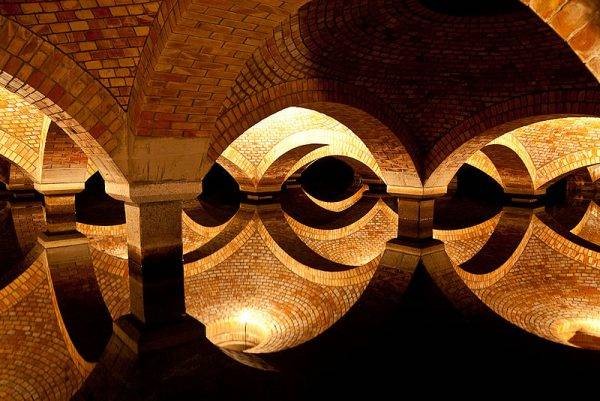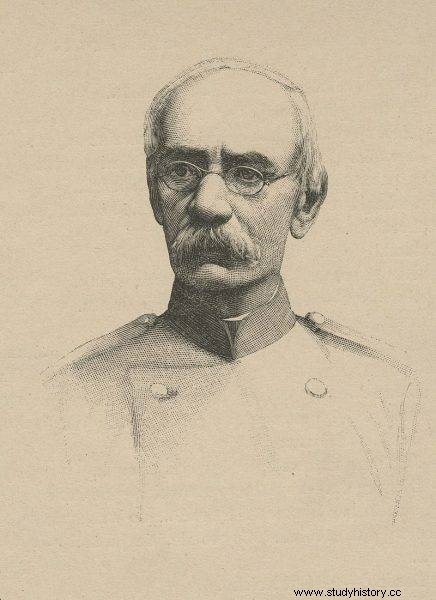The best president in the history of Warsaw was ... a Russian - general Sokrates Starynkiewicz. He ruled in the years 1875–1892. He was said to have brought the capital from the 18th century to the 20th century. Varsovians still use the sewage system built during his tenure.
The general - then retired - came to Warsaw in 1875. The situation he found did not look rosy. Compared to St. Petersburg, Moscow or other European cities, the capital of the Kingdom of Poland looked pale. While in Berlin, the construction of electric trams was commenced and the streets were lit with electric lamps, in Warsaw, horses were still used for transport, and the darkness was illuminated by gas lighting. As one young man from Vilnius noted - Krakowskie Przedmieście was paved with cobblestones, so ears had to be blocked due to the noise caused by the iron wheel fittings.
They flow, sewage flows
Local residents complained about poor water quality. Due to the primitive filtering system, it was mixed with sand during the periods of the Vistula rising. Warsaw houses did not have running water, and even in the city center, not all tenement houses had a tap in the courtyard. Bolesław Prus complained that " our people rarely wash, and they almost never bathe ". Often you saw a starched collar pinned to a dirty shirt; the bath was taken "with a little exaggeration once around Easter". Daily hygiene was limited to rinsing the face and hands in a small basin, only wealthier citizens used to go to the baths.

photo:Robert Parma / CC BY-SA 3.0 The lack of sewage system was a pressing problem in Warsaw
The most severe was the lack of sewage system. Even in the beautiful palaces with marble stairs, there were no toilets. As for the tenement houses, most of their male residents had to go to separate buildings, usually located in the back of the courtyard above the "biological" pit.
Waste-removing wagons circled the streets of Warsaw, poisoning the air from early morning. Gutters ran along the streets. Doctors sounded the alarm that in late spring and summer, due to rotting of the sewers in the city "without any epidemics", about 1.5 thousand inhabitants a month were dying. . When the situation reached a critical level, the General-Governor of Warsaw, Count Paweł Kotzebue, wrote a report to Alexander II:
Debris seeps from yards onto the streets through exposed gutters, giving off foul odors, and then flows into drainage channels, built mostly of wood in the old days, with no plan whatsoever.
These channels are in a completely unsatisfactory condition:they rot, collapse frequently, and are constantly clogged. In addition, these canals do not drain surface water that causes moisture in houses, flood cemeteries, and also do not receive runoff in heavy rains, the existing water supply in Warsaw draws water from the Vistula exactly where sewage flows from city canals.
Cure for ills
A year after taking office, the new president commissioned engineer William Lindley to prepare an investment project, which he took under personal control. He also went to Frankfurt am Main to see with his own eyes how the local sewage system works.
It was necessary to make the inhabitants aware of the benefits of the emergence of the sewage system, so the subject - as reported by Bolesław Prus - was "widely debated" in the capital and soon "the hard shell of universal apathy began to melt." The people of Warsaw learned that the sewage system was to "reduce mud on the streets, dirt in the backyards, purify the air and reduce mortality".

Portrait of Socrates Starynkiewicz
Against this innovation was a powerful lobby of wealthy Warsaw tenement houses, which supported sewerage in the streets while refusing to pay installation fees sewage devices in their buildings. There was also a problem with cumbersome bureaucratic procedures that delayed the financing of the project. Undaunted, Starynkiewicz decided to invest his own savings, and then patiently waited for the state to return his money.
Eventually, the city received a sewage system to drain street sewage and rainwater through underground channels replacing the gutters. Within 7 years, 107 km of water pipes and over 40 km of sewage tunnels appeared.
Amenities continued
Sokrates Starynkiewicz also took care of greenery:over 5,000 trees were planted on the streets of Warsaw, over a dozen neglected squares were renovated, and the gardens of the Saski and Krasiński families were tidied up. In 1882, the first telephones appeared in the city, two years later the crowd on Marszałkowska admired the first electric lanterns. Agrykola and Skaryszewski parks were opened, as well as the Mirów market, which is still operating today. The president also fought to improve hygiene in the capital's markets by ordering regular inspections.
The Orthodox Starynkiewicz treated the followers of Catholicism with respect:during his term of office, the cathedral church of St. Anna and the Church of All Saints, one of the largest Catholic temples in Warsaw, was built. The lack of burial grounds posed an epidemiological threat, so a new cemetery was marked out - Bródno, opened in 1884.
At the same time, the Russian president was a crystal honest man. When the Vistula bottom dredger purchased by the city turned out to be a misguided investment, he felt responsible for this expense and covered the costs of its purchase from ... his daughter's dowry . After the sudden death of the cashier in the town hall, the cashier's cash register was lacking 17,000 rubles, so the president decided to "cover the loss for the same" because, as he wrote in his journal, "I neglected supervision," admitting that the money in his home budget "was not ma, you have to hurry up with the sale of majorat. ”
Recognition in life and after death
Starynkiewicz left office in 1892, but remained in Warsaw. In the eyes of the inhabitants, he was "the president without office", and the employees of the town hall often visited him in a modest apartment on Rysia Street to share news and seek advice. He contributed generously to charities and was a member of the Warsaw Charity Society.

The funeral of Starynkiewicz
He died at the beginning of August 1902. On the day of his funeral, the capital took over a solemn mourning. The Town Hall building was decorated in black and white , street lamps wrapped in black crepe were burned from the morning. On his last journey, Starynkiewicz was accompanied by thousands of Varsovians who were grateful for his devotion to the city.
Shortly after the death of "our president", as the inhabitants called the Russian general, his portrait appeared on the Town Hall building, and on June 4, 1907 - a bust financed by social contributions.
After Poland regained independence, all traces of the Russian presence were destroyed, but no one dared to move the portrait of Starynkiewicz. During the Warsaw Uprising, the bust of the president was destroyed, but in 1996, on the initiative of Miejskie Przedsiębiorstwo Wodociągów i Kanalizacji, it returned to its former place.
Bibliography:
- Paziewska, Warsaw and its Presidents , Vipart, 2009.
- Starynkiewicz, Diary 1887 - 1897 , Warsaw Library, 2005.
- Wiernicka, Russians in Poland. The time of partitions 1795-1915. Bellona, 2015.
- Zaleski, The Warsaw Society. Letters to a friend by Baroness XYZ , PIW, 1971.
